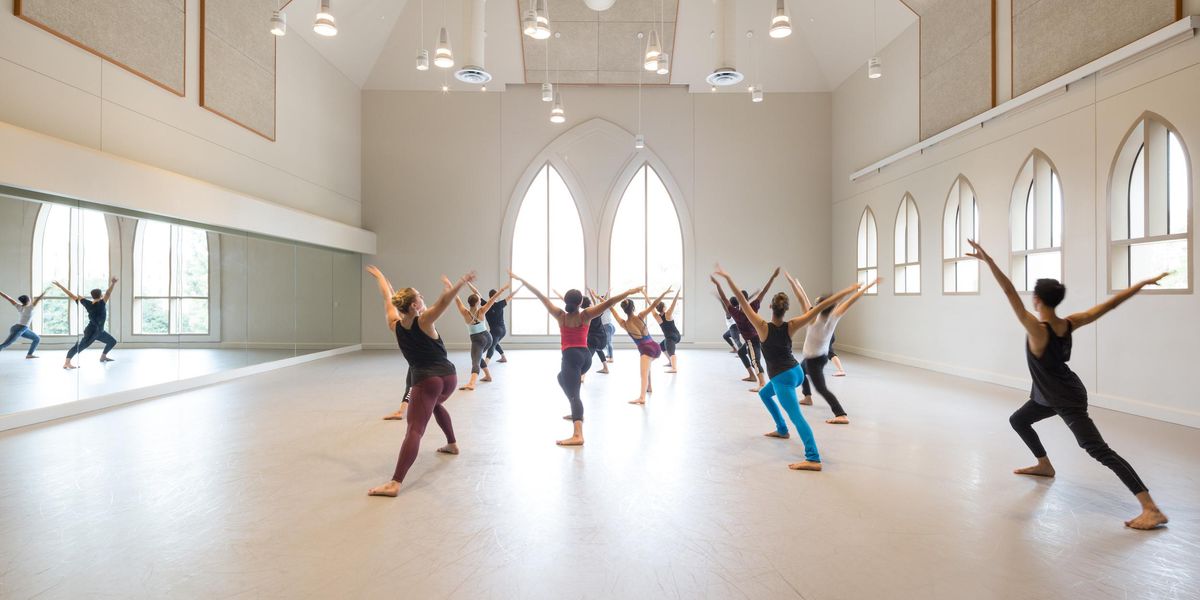Training in Germany
The European dance hub is home to many affordable, innovative schools.
Dance students from Mannheim University of Music and Performing Arts in
REFLEKTION. Photo by Jochen Klenk, Courtesy Mannheim University of Music and Performing Arts.
It’s not often you see Vaganova-trained ballet students and contemporary dancers race through échappés together as the pianist improvises a solo on a drum. But that was the scene last February in the studios of Dresden’s Palucca Hochschule für Tanz. Nearly all of Germany’s state-funded dance schools met there for the Dance Education Biennale, created in 2008 to bring them together periodically for a week of workshops and conferences. Every morning, students mingled in classes ranging from strictly classical to experimental. Bunheads were put through their paces in release-focused exercises; elsewhere, a dancer in casual attire soared through grand allégro combinations with turned-in feet but unmatched ballon.
This relaxed approach to the conventional dichotomy between classical and contemporary is an integral part of the German training philosophy. As one of the few countries to emerge relatively unscathed from the recession, Germany is reasserting its place as a creative hub with few barriers. The country’s most prestigious companies have welcomed a number of American dancers in recent years, including future “Flesh and Bone” star Sarah Hay in Dresden. Choreographers like William Forsythe and John Neumeier have long called it home.
For students dreaming of a career in Europe, studying in Germany may be a strategic step toward securing a company position—or simply a way to broaden their creative horizons. German training institutions have raised their international profile in recent years through increasingly close ties with companies and competitions like the Prix de Lausanne, and roughly 50 percent of advanced students come from abroad at most German schools (80 percent at the School of the Hamburg Ballet).
Germany offers sizeable benefits to dancers in training. Steady state support means tuition fees are almost nonexistent, even for international students: Schools generally require only a yearly registration fee in the $200 to $500 range. The cost of accommodation and living is typically modest, and students have access to very cheap public transportation and comprehensive health care.
A Classical Hotbed
With a wealth of ballet companies, Germany is first and foremost a savvy choice for classically trained dancers. Seemingly every midsize city has a neoclassical ensemble, and the country’s top schools provide many of their dancers. Eighty percent of Hamburg Ballet company members graduated from its school, where Neumeier’s repertoire is taught. Two-thirds of Stuttgart Ballet’s dancers come from the John Cranko Schule, where artistic director Reid Anderson watches talent closely to assess work ethic and readiness. Schools from Munich to Mannheim have partnerships or apprentice programs in place to provide stage experience and exposure. “It’s part of the professional preparation,” says Jan Broeckx, the head of Munich’s Ballet Academy. “We even created a junior company to bring the school and the Bayerisches Staatsballett closer together.”
Contemporary Creativity
The curriculum is Vaganova-based throughout Germany, but contemporary dance, which is considered integral to any dancer’s training, is emphasized everywhere. Institutions like Dresden’s Palucca Hochschule für Tanz and Frankfurt’s University for Music and Performing Arts are bona fide crossovers between classical and contemporary. “Almost no ballet company in Europe does only ballet—you need contemporary dance,” says Jason Beechey, the rector of Palucca. “Our students learn ballet, contemporary and improvisation as equal elements from the beginning. They dance Balanchine, but they also learn to be autonomous, creative.”
German schools tend to welcome creative types: Creativity was the theme of the Dresden Biennale, and is encouraged in every program through composition classes. Funding is getting tighter everywhere, “but you can still experiment and explore in Germany,” says Beechey—the professional world included. “Elsewhere, if it’s not a commercial success, you’re written off. Here, there tends to still be time to try and reflect and build and work.”
“Our students learn ballet, contemporary and improvisation as equal elements.” —Jason Beechey, Rector of Dresden’s Palucca Hochschule für Tanz
Dancing Toward A Degree
There is an additional bonus at most of these schools: the opportunity to earn a bachelor’s degree as part of the training. Bachelor programs start from age 16 in Germany. Since entry criteria are dance-related, no high school diploma is required for foreigners. Degrees in dance or dance pedagogy for future teachers are typically offered, along with language classes if academics are in German. “With this system, if something happens and you can’t dance anymore, you can keep studying in normal universities in Germany,” says Broeckx.
German universities can draw from the country’s rich Tanztheater history, with its mix of expressionist dance, theater and existentialism, to devise their curricula. In Essen, near Wuppertal, training at Folkwang University’s Institute of Contemporary Dance is based on the movement theory of Laban, as well as the work of pioneers like Kurt Jooss—co-founder of Folkwang University—and Sigurd Leeder. The school also has ties with Tanztheater Wuppertal, and collaborates with the Pina Bausch Foundation.
Making The Move
Seventeen-year-old American Tim Leonard, a graduate of the Rock School for Dance Education, took the plunge last year after Beechey spotted him at Youth America Grand Prix. “I was hoping to have another year of training, especially since I hadn’t done any contemporary dance,” he says. Leonard had spent three years in Germany as a child with his military father, though he didn’t learn the language. Dresden took some adjusting, but he relishes the versatility required: “It opens you up to a lot of new possibilities—it’s really helped me develop as an artist.” He now has his heart set on joining Dresden’s Semperoper Ballett.
Studying in Germany remains a bold step. Most schools require students to audition in person, although DVDs can be sent for pre-selection. Thoroughly researching the various schools is a must. “It depends on the individual’s emotional maturity,” says Leonard. “It’s not for everyone, but it’s a great opportunity.”
Chart by Kalee Brunelle




